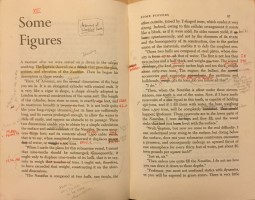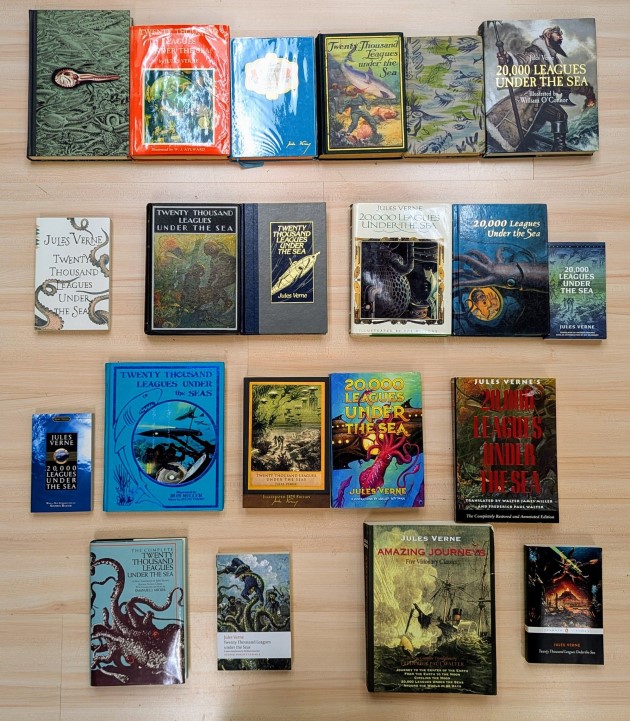This article is a work in progress!
Since it was originally published in France as Vingt milles lieues sous les Mers in 1869, Twenty Thousand Leagues Under the Sea has had quite the history. It been translated and published into English many times: we've counted eleven different translators, but there are more that have been translated anonymously, and some of the translators in the list below have done two or even three different renditions. It has also inspired many artists, from the early engravings, to the painted illustrations of the 20th century and graphic novels of the 21st, to sculpture, films, board-, computer-, and even VR games!

The first English translation was in 1871 by Lewis Mercier. Five years later, another one appeared, translated by Henry Frith. It was nearly half a century before it was translated anew, this time by Phillip Schuyler Allen in 1922. No other translations made their appearance until 1962, when Anthony Bonner published his version, followed closely by Walter Miller's in 1965, and Mendor Brunetti's in 1969.
Mercier's translation became the "standard" English version because for ninety years it was the main English translation, and thus, was the first to enter the public domain. In the past century, there have been literally hundreds of reprints, and today, there are still scores of editions of the Mercier translation available—as opposed to those of Brunetti, Bonner, or Miller—as Mercier's is copyright-free. It has become so ubiquitous, in fact, that many people are unaware that Verne wrote in French! The misconception that he wrote in English is bolstered by the fact that often publishers leave off the name of the old translator.
But Mercier, a Protestant minister and theological writer, didn't really have the background for translating a book full of scientific, technical, and nautical details, and quite often, he translated things incorrectly. For example, at one point Mercier has Nemo explain that iron is lighter than water! Unfortunately, Verne is usually blamed for these errors. Additionally, Mercier cut the text wherever he did not understand Verne's science, or did not agree with his politics or religion. Ultimately, he chopped more than twenty percent of Verne's text; including hundreds of paragraphs of action, narration, and important character developments—even, in one case, an entire chapter. Is it any wonder, then, that for generations, readers of Twenty Thousand Leagues Under the Sea have often found themselves confused about what was going on?
Anthony Bonner's 1962 translation was a great improvement—his language and style are very similar to Verne's; early editions were still missing a number of things, but Bantam cleaned most of these up with its 2007 reprint. Mendor Brunetti's 1969 text is extremely accurate so far as content is concerned, but he heavily rewrote the text so that its style is more Brunetti's than Verne's. Walter James Miller's text from 1965 is considered one of the better renditions, but the text is compressed with narration and dialogue often paragraphed. Miller also edited The Annotated Jules Verne: Twenty Thousand Leagues Under the Sea in which he explains in detail the problems with the "standard" edition, and undertakes to reprint it with the reinstated passages. However, many of Mercier's translation errors are left unexplained, and some of the missing parts are still missing.

Ron (not Walter) Miller released his translation in 1988. He still uses as his core the Mercier translation, which he does because Mercier translated Verne very literally, changing word order only to the degree dictated by the differences in grammar. As a result, the style stays true to Verne's own. But he also made corrections—lots of them. Errors in translation and scientific errors (Mercier's, not Verne's; any mistakes Verne himself made are left unchanged) were all fixed. This amounted to literally several thousand corrections. The style and wording were made as true as possible to the original. (An example is the title: literal translation from original French makes "Seas" plural. This is actually more accurate than "Sea" (singular), but the singular version is more familiar.
(The above is adapted or completely stolen from the Translator's Note of Ron Miller's version)
Since Ron Miller, there have been several more translations: Frederick Paul Walter released his translation in 1991, and in 1993 The Completely Restored and Annotated Edition (translated and with critical materials by Walter James Miller and Frederick Paul Walter) was published. This is considered by the North American Jules Verne Society to be the definitive edition in existence. The Miller/Walter edition still uses Mercier as a base, but this is supplemented with an original translation of those passages that had previously been omitted. (F.P. Walter re-edited his translation one more time for his 2010 Amazing Journeys anthology.)
Every translation since has eschewed Mercier in favor of fully going back to the drawing board. Emmanuel Mickel's 1992 translation uses the original Hetzel (1869, 1870, 1871) French texts as his point of departure, instead of the hackneyed and much-abridged 1928 Hachette text (used by many 20th century translators), and must be recognized as truly professional in its scope and its integrity.
"In addition to his re-translation of the text itself, Mickel is generous with explanatory footnotes (a very Vernian trait). And he also includes a lengthy introduction which discusses a wide variety of biographical, thematic, and critical issues pertinent to Jules Verne’s life and work. Although occasionally based too much (in my opinion) on several early canonical French studies that are now either outdated or highly controversial—like Marc Soriano’s Freudian “psychological” biography of the author, or Allotte de la Fuye’s gossipy “family” biography—Mickel’s critical introduction is one of the most informed (i.e., the best) that I have seen in English. The book also provides a chronology of the events portrayed in Vingt mille lieues sous les mers, a relatively up-to-date critical bibliography, and reprints of many (though not all) of those now-famous Riou, Neuville, and Hildibrand lithographs found in the original. All in all, this Indiana UP publication of The Complete Twenty Thousand Leagues Under the Sea proves to be an excellent translation and a fine piece of scholarship. My only regret is that Mickel did not lend his expertise to some of Verne’s lesser-known but equally-deserving works.
-- Excerpted from Arthur B. Evans, “New and Recycled Translations of Jules Verne,” Science Fiction Studies, 19.2 #57 (July 1992): 261-63.
review obtained 12 Jan 2009 "
Since Mickel, there have been two more published translations—William Butcher's in 1998 (revised in 2019) and David Coward's in 2017.
REFERENCES:

TRANSLATORS:
- Lewis Page Mercier (1871)
(Many editions)
THE YEAR 1866 was signalized by a remarkable incident, a mysterious and inexplicable phenomenon, which doubtless no one has yet forgotten. Not to mention rumors which agitated the maritime population, and excited the public mind, even in the interior of continents, seafaring men were particularly excited. Merchants, common sailors, captains of vessels, skippers, both of Europe and America, naval officers of all countries, and the governments of several states on the two continents, were deeply interested in the matter.
For some time past, vessels had been met by "an enormous thing," a long object spindle-shaped, occasionally phosphorescent, and infinitely larger and more rapid in its movements than a whale.
- Henry Frith (1876)
(Everyman, Vintage Press)
THE YEAR 1866 was marked by a very strange event, an inexplicable and unexplained phenomenon, which must still be in the recollection of our readers. Without mentioning rumours which agitated the population of the sea-ports, and extended to the interior of various countries, the maritime population were more particularly exercised in their minds. Merchants, ship- owners, ship-captains, skippers, and masters, both European and American, officers of the Marines of both countries, and, subsequently, the Governments of various States of these continents, were deeply engrossed respecting this phenomenon.
As a matter of fact, for some time many vessels had encountered "an enormous thing", long, spindle-shaped, phosphorescent at times - very much larger and swifter than a whale.
- Philip Schuyler Allen (1922)
(Windermere editions, Reader's Digest, Dover 0486448495)
The year of grace 1866 was made memorable by a marvelous event which doubtless still lingers in men's minds. No explanation for this strange occurrence was found, and it soon came to be generally regarded as inexplicable. A thousand rumors were current among the population of the seacoasts and stirred the imagination of those millions who dwelt inland far from the shores of an ocean. But of course it was the seafaring men who were most excited. And everyone in Europe or America that had to do with navigation was deeply interested in the matter—whether sailors or merchants, captains or pilots, naval officers or rulers of empire.
For some time prior to the opening of our story ships at sea had been met by an enormous object, a long thing shaped like a spindle and infinitely larger and more rapid in its movements than a whale.
- Anthony Bonner (1962)
(Illustrated Junior Library with errors, adapted Books of Wonder, Bantam Classics with revised and improved text)
THE YEAR 1866 was marked which by a strange event, an unexplainable occurrence which is undoubtedly still fresh to everyone's memory. Those living in coastal towns or in the interior of continents were aroused by all sorts of rumors, but it was seafaring people who were particularly excited. Merchants, shipowners, captains, skippers and masters of Europe and America, naval officers of all countries and the various governments of both continents were deeply concerned over the matter.
Several ships had recently met at sea "an enormous thing," a long slender object which was sometimes phosphorescent and which was infinitely larger and faster than a whale.
- Walter James Miller (1965, revised 1976)
(Washington Square)
Eighteen sixty-six was marked by a strange occurrence, an amazing phenomenon that probably no one has yet forgotten. People living along the coasts, even people far inland, were disturbed by bizarre rumors. But seafaring men were especially upset. Merchants, sailors, skippers of Europe and America, naval officers of many nations, heads of state on both continents, all were deeply concerned.
Ships at sea had encountered "an enormous thing," a long, spindle-shaped object, sometimes phosphorescent, and infinitely larger and faster than any whale.
- Mendor Brunetti (1969)
(Signet)
THE YEAR 1866 was marked by a strange occurrence, an unexplained and inexplicable phenomenon that surely no one has forgotten. People living along the coasts, and even far inland, had been perturbed by certain rumors, while seafaring men had been especially alarmed. Merchants, shipowners, captains and skippers throughout Europe and America, naval officers of many nations, and governments on both continents—all were deeply concerned.
The fact was that for some time a number of ships had been encountering, on the high seas, "an enormous thing," described as a long, spindle-shaped object that was sometimes phosphorescent, and infinitely larger and faster than a whale.
- Ron Miller (1988)
(Unicorn)
The year 1866 was signalized by a bizarre incident, a mysterious and inexplicable phenomenon, which doubtless no one has yet forgotten. Not to mention rumors which agitated the maritime population and excited the public mind, even in the interior of continents, seafaring men were particularly excited. Merchants, common sailors, captains of vessels, skippers and masters both of Europe and America, naval officers of all countries, and the Governments of several states on the two continents, were deeply interested in the matter.
For some time past, vessels had been met by "an enormous thing," a long object, spindle-shaped, occasionally phosphorescent, and infinitely larger and more rapid in its movements than a whale.
- Frederick Paul Walter (1991, revised 2010)
(Seawolf, First Racehorse)
The year 1866 was marked by a bizarre development, an unexplained and downright inexplicable phenomenon that surely no one has forgotten. Without getting into those rumors that upset civilians in the seaports and deranged the public mind even far inland, it must be said that professional seamen were especially alarmed. Traders, shipowners, captains of vessels, skippers, and master mariners from Europe and America, naval officers from every country, and at their heels the various national governments on these two continents, were all extremely disturbed by the business.
In essence, over a period of time several ships had encountered "an enormous thing" at sea, a long spindle-shaped object, sometimes giving off a phosphorescent glow, infinitely bigger and faster than any whale.
- Emanuel J. Mickel (1992)
(Indiana Press 0253338107)
The year 1866 was marked by a strange event, an unexplainable occurrence which is undoubtedly still fresh in everyone's memory. Those living in coastal towns or in the interior of continents were aroused by all sorts of rumors; but it was sea- faring people who were particularly excited. Merchants, shipowners, skippers and masters of Europe and America, naval officers of all countries and the various governments of both continents were deeply concerned over the matter.
Several ships had recently met at sea "an enormous thing," a long slender object which was sometimes phosphorescent and which was infinitely larger and faster than a whale.
- Walter James Miller AND Frederick Paul Walter (1993)
(Naval Institute Press 0870216781)
THE YEAR 1866 was marked by a bizarre situation, a phenomenon unexplained and inexplicable that probably no one has yet forgotten. Putting aside those rumors that upset people in the seaports and excited the public mind far inland, the significant fact is that seafaring men were especially agitated. Merchants, shipowners, ships' captains, skippers and masters from Europe and America, naval officers of all nations, and finally the various governments on those two continents, all became deeply concerned.
For some while, ships at sea had encountered "an enormous thing," a long spindle-shaped object, sometimes phosphorescent, infinitely bigger and faster than any whale.
- William Butcher (1998, revised and expanded in 2019)
(Oxford Press 0192828398)
THE year 1866 was marked by a strange event, an unexplained and inexplicable occurrence that doubtless no one has yet forgotten. Without mentioning the rumours which agitated the denizens of the ports and whipped up the public's imagination on every continent, seafaring men felt particularly alarmed. The businessmen, ship-owners, sea-captains, skippers, and master-mariners of Europe and America, the naval officers from every country, and finally the various national governments on both continents—all became extremely worried about this matter.
For some time already, sea-going ships had been encountering an 'enormous thing': a long spindle-shaped object, sometimes phosphorescent, but infinitely larger and quicker than a whale.
- David Coward (2017)
(Penguin Classics 0141394935)
The year 1866 was marked by a strange occurrence, an unexplained and indeed inexplicable phenomenon which surely no one can have forgotten. Though rumours abounded which alarmed the populations of ports and inflamed public sentiment in the interior of every continent, it was seafaring folk who felt the most afraid. Merchants, shipping companies, the captains of vessels, the skippers of boats and the marine commanders of Europe and America, officers of the navies of every nation and, in their wake, the governments of various countries of both continents, all gave their whole attention to the question and allocated it the highest priority.
The fact of the matter was that, for some time past, various ships at sea had encountered a long cigar-shaped object which could at times be phosphorescent and was infinitely larger and faster than a whale.
ILLUSTRATORS:
The earliest illustrators for Vingt milles lieues sous les Mers were in Pierre-Jules Hetzel's editions by Edouard Riou, who contributed 24 illustrations to the first eleven chapters, and Alphonse de Neuville, who inked 86 images for the rest of the book. There were also wood engravings by Hildibrand. Verne wrote in 1868:
"I have received the drawings from Riou. I have several suggestions to make which I'll mention to him by return mail. I think he needs to make the people much smaller and the rooms much larger. And he needs to add much more detail... By the way, it was an excellent idea to use Colonel Charras as the model for Captain Nemo. I should've thought of that."
Both the Seawolf Press and the Indiana Press include their art; Seawolf has all 110 illustrations but the Indiana Press edition only has a selection. To get a better sense of their art, we offer here a pair of links to Wikipedia Commons: Page 1 | Page 2
LATER ILLUSTRATORS (alphabetical):
Did you find this review helpful?